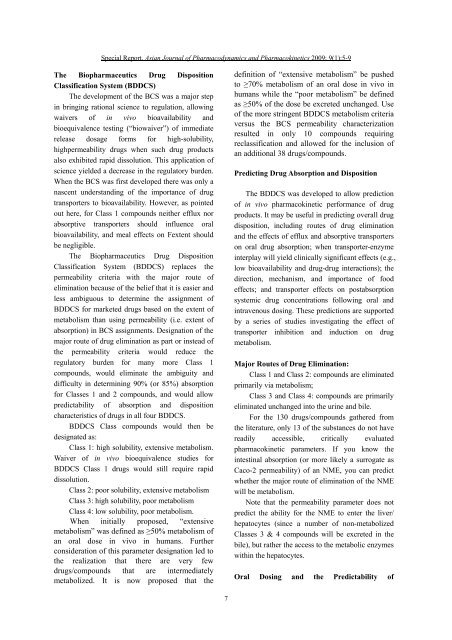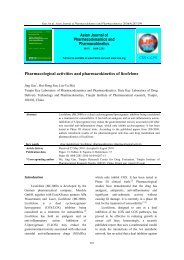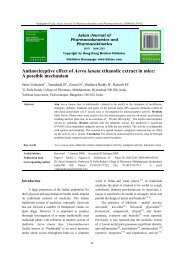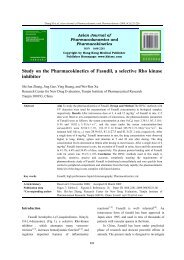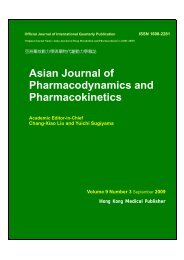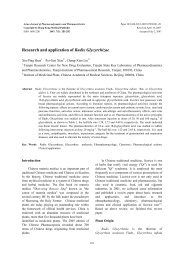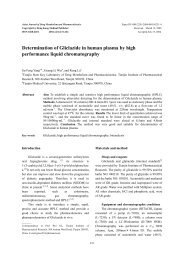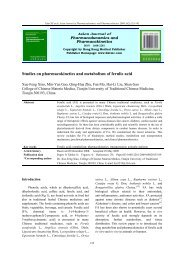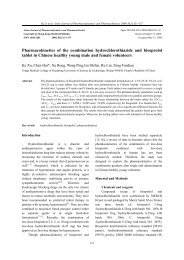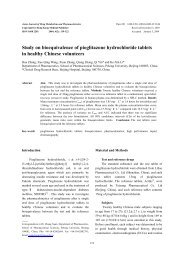Asian Journal of Pharmacodynamics and Pharmacokinetics
Asian Journal of Pharmacodynamics and Pharmacokinetics
Asian Journal of Pharmacodynamics and Pharmacokinetics
You also want an ePaper? Increase the reach of your titles
YUMPU automatically turns print PDFs into web optimized ePapers that Google loves.
Special Report. <strong>Asian</strong> <strong>Journal</strong> <strong>of</strong> <strong>Pharmacodynamics</strong> <strong>and</strong> <strong>Pharmacokinetics</strong> 2009; 9(1):5-9<br />
The Biopharmaceutics Drug Disposition<br />
Classification System (BDDCS)<br />
The development <strong>of</strong> the BCS was a major step<br />
in bringing rational science to regulation, allowing<br />
waivers <strong>of</strong> in vivo bioavailability <strong>and</strong><br />
bioequivalence testing (“biowaiver”) <strong>of</strong> immediate<br />
release dosage forms for high-solubility,<br />
highpermeability drugs when such drug products<br />
also exhibited rapid dissolution. This application <strong>of</strong><br />
science yielded a decrease in the regulatory burden.<br />
When the BCS was first developed there was only a<br />
nascent underst<strong>and</strong>ing <strong>of</strong> the importance <strong>of</strong> drug<br />
transporters to bioavailability. However, as pointed<br />
out here, for Class 1 compounds neither efflux nor<br />
absorptive transporters should influence oral<br />
bioavailability, <strong>and</strong> meal effects on Fextent should<br />
be negligible.<br />
The Biopharmaceutics Drug Disposition<br />
Classification System (BDDCS) replaces the<br />
permeability criteria with the major route <strong>of</strong><br />
elimination because <strong>of</strong> the belief that it is easier <strong>and</strong><br />
less ambiguous to determine the assignment <strong>of</strong><br />
BDDCS for marketed drugs based on the extent <strong>of</strong><br />
metabolism than using permeability (i.e. extent <strong>of</strong><br />
absorption) in BCS assignments. Designation <strong>of</strong> the<br />
major route <strong>of</strong> drug elimination as part or instead <strong>of</strong><br />
the permeability criteria would reduce the<br />
regulatory burden for many more Class 1<br />
compounds, would eliminate the ambiguity <strong>and</strong><br />
difficulty in determining 90% (or 85%) absorption<br />
for Classes 1 <strong>and</strong> 2 compounds, <strong>and</strong> would allow<br />
predictability <strong>of</strong> absorption <strong>and</strong> disposition<br />
characteristics <strong>of</strong> drugs in all four BDDCS.<br />
BDDCS Class compounds would then be<br />
designated as:<br />
Class 1: high solubility, extensive metabolism.<br />
Waiver <strong>of</strong> in vivo bioequivalence studies for<br />
BDDCS Class 1 drugs would still require rapid<br />
dissolution.<br />
Class 2: poor solubility, extensive metabolism<br />
Class 3: high solubility, poor metabolism<br />
Class 4: low solubility, poor metabolism.<br />
When initially proposed, “extensive<br />
metabolism” was defined as ≥50% metabolism <strong>of</strong><br />
an oral dose in vivo in humans. Further<br />
consideration <strong>of</strong> this parameter designation led to<br />
the realization that there are very few<br />
drugs/compounds that are intermediately<br />
metabolized. It is now proposed that the<br />
definition <strong>of</strong> “extensive metabolism” be pushed<br />
to ≥70% metabolism <strong>of</strong> an oral dose in vivo in<br />
humans while the “poor metabolism” be defined<br />
as ≥50% <strong>of</strong> the dose be excreted unchanged. Use<br />
<strong>of</strong> the more stringent BDDCS metabolism criteria<br />
versus the BCS permeability characterization<br />
resulted in only 10 compounds requiring<br />
reclassification <strong>and</strong> allowed for the inclusion <strong>of</strong><br />
an additional 38 drugs/compounds.<br />
Predicting Drug Absorption <strong>and</strong> Disposition<br />
The BDDCS was developed to allow prediction<br />
<strong>of</strong> in vivo pharmacokinetic performance <strong>of</strong> drug<br />
products. It may be useful in predicting overall drug<br />
disposition, including routes <strong>of</strong> drug elimination<br />
<strong>and</strong> the effects <strong>of</strong> efflux <strong>and</strong> absorptive transporters<br />
on oral drug absorption; when transporter-enzyme<br />
interplay will yield clinically significant effects (e.g.,<br />
low bioavailability <strong>and</strong> drug-drug interactions); the<br />
direction, mechanism, <strong>and</strong> importance <strong>of</strong> food<br />
effects; <strong>and</strong> transporter effects on postabsorption<br />
systemic drug concentrations following oral <strong>and</strong><br />
intravenous dosing. These predictions are supported<br />
by a series <strong>of</strong> studies investigating the effect <strong>of</strong><br />
transporter inhibition <strong>and</strong> induction on drug<br />
metabolism.<br />
Major Routes <strong>of</strong> Drug Elimination:<br />
Class 1 <strong>and</strong> Class 2: compounds are eliminated<br />
primarily via metabolism;<br />
Class 3 <strong>and</strong> Class 4: compounds are primarily<br />
eliminated unchanged into the urine <strong>and</strong> bile.<br />
For the 130 drugs/compounds gathered from<br />
the literature, only 13 <strong>of</strong> the substances do not have<br />
readily accessible, critically evaluated<br />
pharmacokinetic parameters. If you know the<br />
intestinal absorption (or more likely a surrogate as<br />
Caco-2 permeability) <strong>of</strong> an NME, you can predict<br />
whether the major route <strong>of</strong> elimination <strong>of</strong> the NME<br />
will be metabolism.<br />
Note that the permeability parameter does not<br />
predict the ability for the NME to enter the liver/<br />
hepatocytes (since a number <strong>of</strong> non-metabolized<br />
Classes 3 & 4 compounds will be excreted in the<br />
bile), but rather the access to the metabolic enzymes<br />
within the hepatocytes.<br />
Oral Dosing <strong>and</strong> the Predictability <strong>of</strong><br />
7


